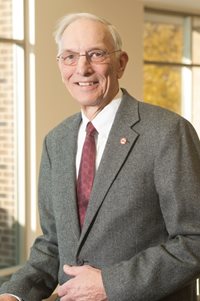A Time to Serve, A Time to Give Back

“I don’t fully recall this,” he says, with a laugh, “but a sixth-grade classmate tells me that when our teacher asked what we wanted to be when we grew up, and other boys were saying cowboys and firemen, I said I wanted to be a physician. I know that by the eighth grade my mind was made up—I did want to be a doctor.”
And it happened. After studies at Dartmouth College, Dartmouth Medical School, the National Institute of Health, and the University of Minnesota Medical School, Hanson came to Park Nicollet in 1971 to begin a distinguished 40-year career specializing in pulmonology.
By the early ‘80s, Hanson was an active member of the Minnesota Medical Association (MMA), including a stint as president. As a delegate to national AMA conventions, he also became a leader in anti-smoking campaigns, a cause he still champions. Recently he played a role in a successful effort to ban flavored tobacco products in Minneapolis convenience stores.
“I’m very thankful for people who made sacrifices on my behalf.
Giving back is a way to express that gratitude.”
Hanson and his wife, Gail, who both grew up around south Minneapolis lakes, now reside in downtown Minneapolis. Retirement is great, but busy. “I do everything I used to do except go to work,” he says. The Hansons enjoy family, travel (including a recent 108-day world-circling cruise), and on-going professional connections, including his role as co-chair of the U of M Medical School’s Admission Committee. He’s even started a memoir. “I failed freshman English,” he says, “but I want to write something for my grandkids to read some day.”
Retirement—if not before—is also an excellent time to focus on big questions, Hanson says.
“You start to wonder, ‘what will I leave behind?’ What will my legacy be?” he says. “Three core values that were important to me throughout my career help me answer those questions: One, patients come first. Second, base whatever you do on the best available science. And three, give back to your community.”
Giving back should be a key priority for doctors, Hanson believes. “I think of teachers I had in medical school, and others who helped train me. I’m very thankful for people who made sacrifices on my behalf. Giving back is a way to express that gratitude.”
How do you make the practical plans about giving back?
Gail and I have done a family financial analysis with a professional about every five years,” he explains. “We decide how much we want to give and where those gifts will go. We identify organizations we want to help continue after we’re gone, with a special focus on ones that meet health-care needs.”
The long-term viability of those charities is a factor, he adds.
“No one can predict the future or know the full scope of what will be needed in coming years,” he says. “But we want to contribute to causes and organizations that will likely still be around 30 to 50 years from now.”
One organization the Hansons have chosen to support is the MMA Foundation, for a number of reasons.
“The Foundation gives young doctors opportunities to practice in urban and rural settings that face challenges in attracting medical personnel,” he says. “The Foundation also addresses growing disparities. Statistics project that by 2030 Minnesota’s minority population will approach 30%; currently the percentage of students of color at the U of M Medical School is less than 20%. We need to catch up in those areas. MMAF scholarships can help.”
A big dream, a great career, a commitment to give back. “I would not have had the medical career I did without the help of many people,” says Hanson. “Now it’s my turn to help the next generation of medical students. I am glad to do it.”
For more information on how you can support the work of the MMA Foundation through a bequest, visit the MMA Foundation’s Charitable Bequests web page. Thank you!
Story by Steve Harris
Photo by Pete Crouser
